With a Golden Jubilee Regatta being planned for New Zealand in 2015 to celebrate the glory years of the One Ton Cup from 1965 to 1983, W M Nixon ponders on the requirements for a genuine classic yacht or traditional boat, and makes a plea for saving a very special 12 Metre.
It's said there are enough relics of the True Cross to build a full-size replica of Noah's Ark. You'd need to be very clever with the epoxy saturation techniques to do it, as most of the pieces are very small. But apparently it's reckoned the required volume of timber is out there at shrines throughout the world.
This question of ancient or even vintage authenticity arose as soon as last week's blog about the Peel Traditional Boat Weekend appeared. One commentator, while not prepared to put his head above the parapet even under anonymity in the proper comments section, was quick to point out that not only is it obviously not a weekend as it runs from Wednesday night until Monday, but the three awards winners mentioned were clearly not as they seemed.
The lovely little Menai Straits-based schooner Vilma, while evoking memories of the Welsh slate schooners, is no such thing. She started life as a ketch-rigged Danish fishing boat in 1934. As for the startling bisquine-rigged 50-footer Peel Castle from West Cork, we're in Disneyland. She was originally a motorised Penzance fishing boat built in Porthleven in 1929. But after nine years of patient restoration work completed in the Ilen River in West Cork in 2008, this exotically rigged vessel with her three masts fanning every which way sailed happily to Greece where, one would guess, her rig seemed very much at home.
And as for the "Best in Show" awardee, the 36ft Ainmara, only her hull and deck are as designed and built by John B Kearney in Ringsend in 1912. In Kearney's eleven years of ownership, she set a nuggety little gaff yawl rig with a keel-stepped mainmast only 37ft 6ins in overall length. But these days, she sports a sky-scraping Bermudan rig set on a deck-stepped alloy mast which the owner built himself, and painted brown to look like wood. As for her high-rise coachroof, that was installed in the late 1920s by Harland & Wolff in Belfast, whose speciality was ocean liners, and it shows.
Of the boats whose photos we displayed last weekend, only the little Albert Strange yawl Emerald, the Ramsey longliner Master Frank, the Pilot Cutter Madcap, the cruising cutter Dreva, the Manx nobby White Heather, and the 57ft 1957-vintage offshore racer Drumbeat looked anything like they did originally. The Galway Hooker Naomh Cronan was also of course authentic in appearance, but she was a new build of 15 years ago to the ancient design.
As for the others present in a large and eclectic fleet, many were old boats modified, sometimes very extensively, to provide individualistic vessels suited to the owners' tastes and particular requirements. Being an almost pathological boat modifier myself, I have to confess that my sympathies were largely with these boat changers. Whatever the outcome of their efforts, they were always interesting, and in most cases resulted in a much-improved boat, the success of the modifications being attested to by the very fact that they were at Peel and looking so well they picked up prizes.
But that said, our visit at the beginning of the "weekend" across to the 224-year-old Peggy at Castletown had brought something of an epiphany. She is an object of veneration. There was something extraordinarily moving about seeing and touching the boat which George Quayle had taken across the Irish Sea in 1796 to race successfully against the Windermere yachts. For sure, Quayle changed the Peggy about all the time in her very early years. But the boat we see and sense today is pretty much the boat of 1796, and her conservation planned for 2014 will be watched with special interest.
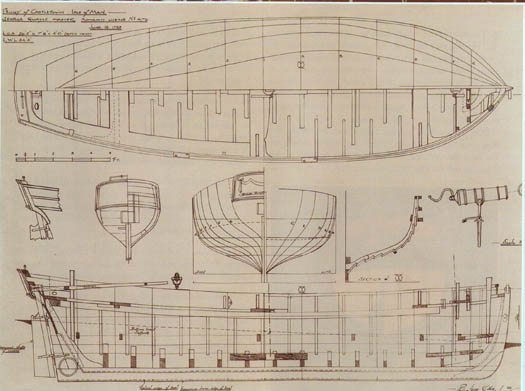
Hull details of the 1789-built Peggy of Castletown. Though the modifications added within three or four years of her building are evident, this is largely the boat which was taken to Windermere in 1796. While the original boat is being conserved during 2014, it is high time somebody in the Isle of Man thought of building a replica to go sailing.
She's of such historical significance that she's definitely not for sailing again. But as she has had her lines taken off and her construction details annotated, it strikes me that it's high time somebody in the Isle of Man built a replica to take out sailing. It would certainly add something very special to the Peel Weekend, a matter of entertainment and interest rather than obscure arguments about authenticity. But as the classic boat movement continues to gather pace, the arguments about what is or is not a genuine classic grow with it, and the heat of the argument has nothing to do with the size of the boats involved.
Thus at the delightful little port of Bosham in Chichester Harbour down in West Sussex, passions have been aroused at what is now the premier vintage and classic dinghy regatta, the Bosham Revival. The Portsmouth Yardstick handicap system is allegedly being exploited by some boats in the 14ft Merlin Rocket class, a vintage developmental design where boats which are effectively new build are being passed off as originals to the historic Jack Holt Passing Cloud design. This is being done on the basis of including an ancient thwart or knee from an otherwise totally decayed original.
Such an approach has been an embarrassing part of the classic yacht restoration movement from the start. By contrast, we are all aware of the painstaking care Hal Sisk and his team went to in restoring the 1894 Watson cutter Peggy Bawn, treading carefully on the lines between restoration, re-build and new build. As for conservation, if you claim you've conserved an historic boat, then it's a museum piece, and won't sail again.
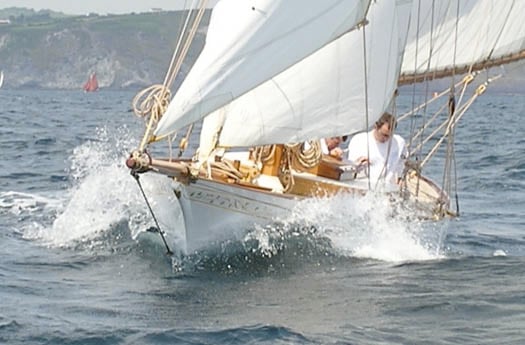
Absolutely oozing authenticity.......the restoration of the 1894 Watson cutter Peggy Bawn by Hal Sisk and his team provides a global benchmark. She is seen here at Glandore Classic Regatta.
But of course, in revitalising significant and almost derelict old boats, the desire to sail them again is probably the prime motivation. And as for what qualifies as a classic and authentic under some old measurement rule, we're likely to see yet another wave of debate with the news that the great Chris Bouzaid and a team in the Royal New Zealand YS plan to celebrate the Golden Jubilee of the One Ton Cup's best era in New Zealand in 2015.
As mentioned here in a recent blog, the One Ton Cup was originally presented in 1898 by the Earl of Granard (later the Commodore of the National YC in Dun Laoghaire in the 1930s) for international racing in France between boats rating One Ton under a French measurement rule. It later lay dormant for a long time, but then in 1965 it was revived for RORC level rating competition for boats around 36ft LOA in an instantly successful series at Le Havre.
That was won by the Sparkman & Stephens-designed Diana from Denmark, a classic S & S offshore racer of the time, with rudder attached to the trailing edge of the keel. But 1965 was also the year in which a young American, Dick Carter, won the Fastnet with his own-designed 33ft Rabbit, steel built with separate spade rudder. So for the 1966 One Ton Worlds in Denmark, Carter turned up with the new steel 37ft Tina, beautifully built by the Maas Brothers in Breskens for Ted Stettinius, and they won the One Ton Cup from an exceptionally competitive international fleet.
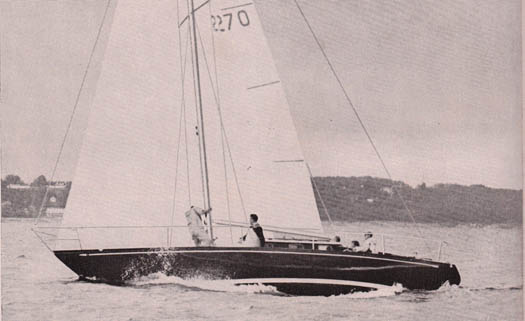
The quality of the steelwork in Tina's hull is evident as she heads for victory in the 1966 One Ton Worlds.
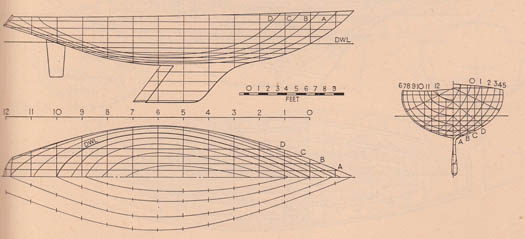
The hull lines of Tina reflected Dick Carter's enthusiasm for the sections of the boats built to classic Scandinavian Square Metre Rules such as the 30 Square Metre. Steel was used to build the hull as Carter reckoned it conferred a rating advantage under the RORC rule, but it also enabled the skilled Maas Brothers builders to create an extraordinarily slim keel which was still sweetly faired at the garboards.

Dick Carter was the first to discern just how much rating advantage could be obtained by a large foretriangle under the RORC Rule in the mid-1960s, and as a result Tina's sailplan looks very odd today.
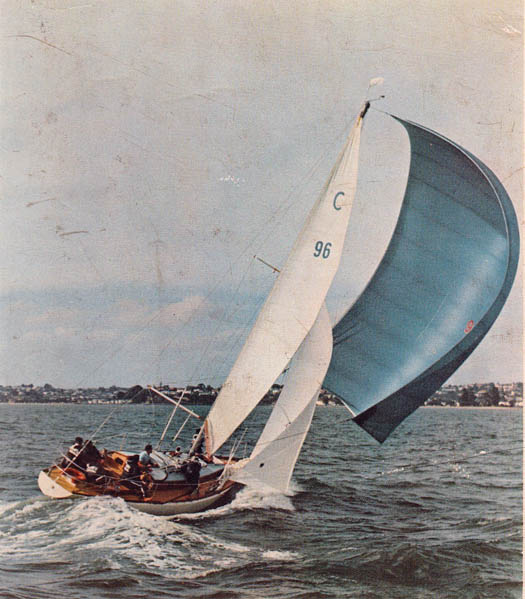
Chris Bouzaid's S & S design Rainbow from New Zealand won the One Ton Worlds in 1969 - and she also won the Sydney-Hobart Race.
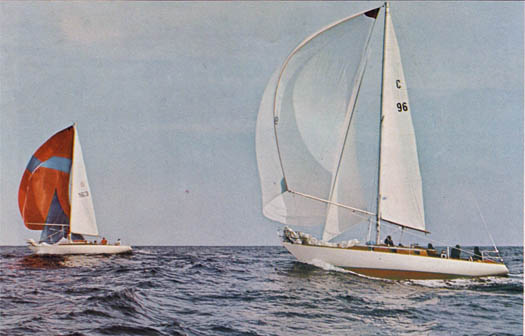
The moment of truth in the final race – an offshore event – in the 1969 One Ton Worlds. Although Carter-designed boats were supposed to be better off the wind, while S & S designs excelled to windward, in the final miles running to the finish of the concluding offshore race Rainbow (right) wore down the defending German champion, the Carter-designed Tina-derived Optimist, and snatched the lead to take the One Ton Cup back to Auckland.
Carter designs won again in 1967 and 1968, but in 1969 with the racing from Heligoland in the midst of the North Sea, it was the very dedicated crew of the Bouzaid team from New Zealand with the Sparkman & Stephens-designed Rainbow who took the trophy. After that, the One Ton Cup had a dozen glorious years, typical being 1974 when the whole world focussed on the racing between Hugh Coveney's Ron Holland-designed Golden Apple from Cork and Jeremy Rogers' Doug Peterson-designed Gumboots from England, with Gumboots taking the win by a hairsbreadth.
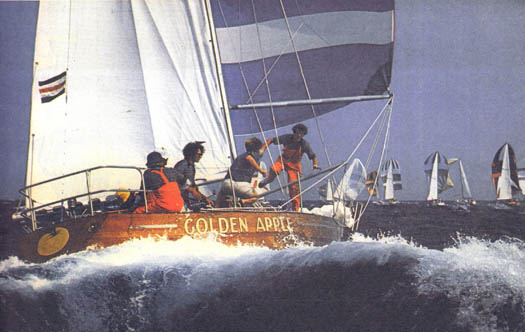
This would be another gold standard participant in the One Ton Golden Jubilee Regatta in New Zealand in 2015. The 1974 Ron Holland-designed Golden Apple, owned by Hugh Coveney and built in Cork by Killian Bushe with Harold Cudmore as skipper, almost won the One Ton Cup, and was one of world sailing's superstars in the mid-70s. Photo: Courtesy RCYC
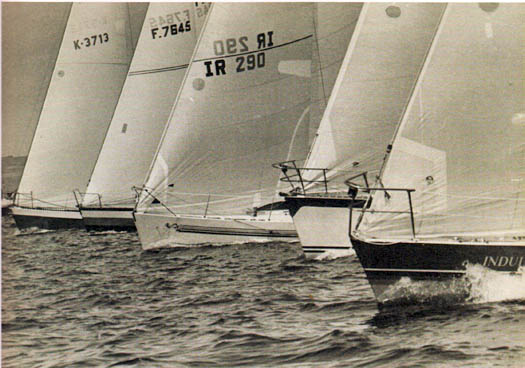
When Ireland finally won.....close-packed start at the One Ton Worlds at Cork in 1981, when the NYC's Frank Woods entered the Castro-designed Justine III (IR 290) with Harold Cudmore as skipper. In this challenging set-up, the positioning of Justine is a joy to behold. Photo courtesy RCYC
Golden Apple's main sailor had been Harold Cudmore, and after he'd won the Half Ton Cup in 1976, the One Ton Cup finally became his when he skippered the NYC's Frank Woods' Castro-designed Justine III to victory in the 1981 series at Cork. But in 1984 with the RORC Rule being replaced by the IOR, One Ton cuppers around 36ft became history, so the suggestion from New Zealand is that the Golden Jubilee Regatta should be restricted to the absolute classics created by the RORC Rule between 1965 and 1983.
Heaven knows there are enough of them about, but for most folk thirty years ago is a very long time, so fifty must seem like eternity. This is something which struck me a few years back up in Killbegs in Donegal when I was trying to get an arty photo, framed by the bows of super-trawlers, of a white boat lying to a mooring in sunshine. She looked like a Dick Carter boat, and when a little puff of wind swung her stern to, the name on the transom showed this wasn't just any old Dick Carter boat. This was Tina.
Quite what she was doing in Donegal I don't know, though I believe her owner lived in that mountainous county. But I haven't seen her there during the past few years, even though the local yacht fleet is increasing, with Killybegs due to get a 65-boat marina, while Killybegs Sailing Club is an important part of the northwest triumvirate of Killybegs SC, Mullaghmore SC, and Sligo YC.
So it's now a long way indeed from the old days when that late great Killybegs fishing skipper James MacLeod was so keen on the sea that in his time off fishing he nipped down to Rosses Point to race his GP 14 with the Sligo fleet. Now there was a man, and no mistake.
This morning, however, the current whereabouts of Tina have added interest with the news of the One Ton Golden Jubilee in New Zealand in 2015. Having seen the interest which the Half Ton Classics have engendered, we can guess at some of the boats which will emerge in order to be eligible for the One Ton Classics in 2015. But in such a line-up, the steel-built Tina of 1966 would be Gold Standard.
With classics restoration, you need a balance between love of old boats, and a can-do ability. Obviously you also need lots of money, but that could be disastrous in itself, as the spirit of the boat has to be preserved. Many rich people automatically think new is best, and in purely functional terms it is certainly much better value, but with classic boats and yachts, you're into strange territory.
A case in point is to be found on the shores of Chichester Harbour, where the mortal remains of the 12 Metre Flica are to be found in a shed beside the marina at Birdham Pool, which is itself a place of historical fascination, as it was the first yacht harbour to be created in a pool which backed up an old tide mill.
Flica was the big boat around Cork Harbour in the 1950s. Owned by a man of style, Aylmer Hall, she exuded all the style of a classic which had been designed by the great Charles E Nicholson in 1928, working in conjunction with the tank and wind-tunnel research team of the owner, aviation magnate Richard Fairey.
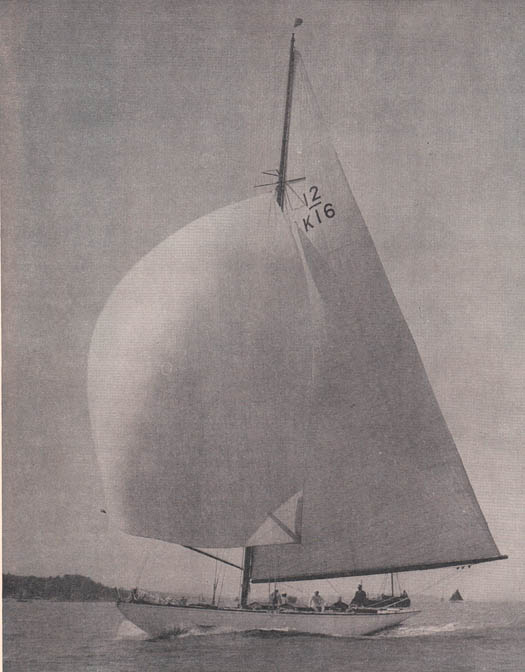
During the period 1928-1938. Flica was the most successful 12 Metre of all in the Solent. She is seen here off Cowes under the ownership of Hugh Goodson in 1936.
In terms of longevity at the sharp end of the 12 Metre fleet, Flica was only to be rivalled by the Sparkman & Stephens designed Vim which appeared in 1939, but as World War II interrupted international racing for the Twelves, it was Flica which had the longest run of success, and she was reckoned as the boat to beat for much of the 1930s when she was owned by Hugh Goodson.
The 12 Metres of that era – boats around 66ft in overall length – were wellnigh perfect, being elegant of appearance, manageable in size, and yet large enough to be impressive. Thus it was a stroke of genius by Aylmer Hall to acquire Flica in 1950 when life in Ireland was becoming decidedly dull and small-minded, for Flica was none of these things. To add greatly to gaiety of the nation and life's rich tableau, she even managed to be spectacularly dismasted during the Cobh People's regatta of 1957, fortunately without anyone being seriously injured, but they talked of little else around Cork Harbour for years.
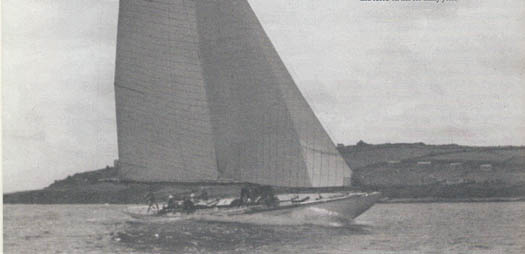
When Aylmer Hall brought Flica to Cork Harbour in 1950, he introduced much-needed style when there was little enough of it about in Ireland. Photo courtesy RCYC
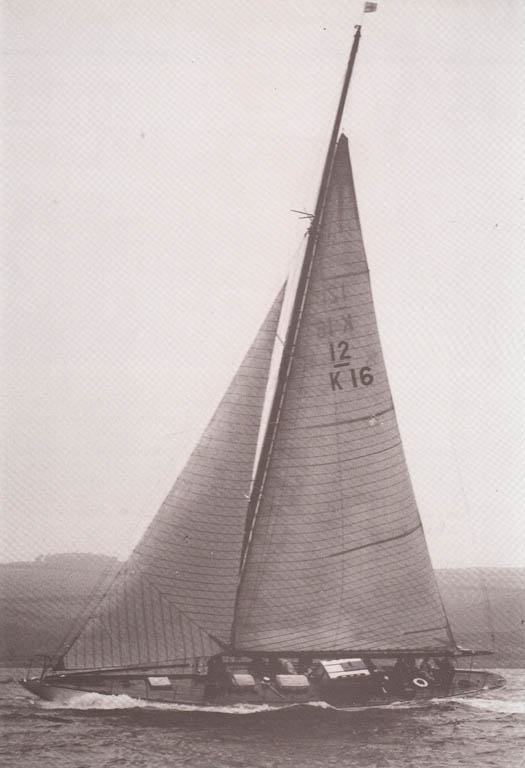
Flica storming seaward from Cork Harbour on a less-than-summery day. At such times, people wondered what it would be like if her mast broke. At Cobh People's Regatta in 1957, they got their answer, but fortunately nobody was seriously injured.
Quite how this supreme classic is now mouldering in the shed at Birdham I don't know, and perhaps I'd rather not know, as it must be a great sadness for someone. I first happened upon her in 2012, and already it looked as though restoration had long since ground to a halt. In late September this year, there was little or no change, only more dust, so much so that the locals must see her now as part of the scenery, an inexplicable bit of background which is simply accepted.

Flica as she was in late September 2013, awaiting a restoration which seems to have ground to a halt. Photo: W M Nixon

Flica is now a long way from the Solent champion of the 1930s, and the Queen of Cork Harbour in the 1950s. Photo: W M Nixon
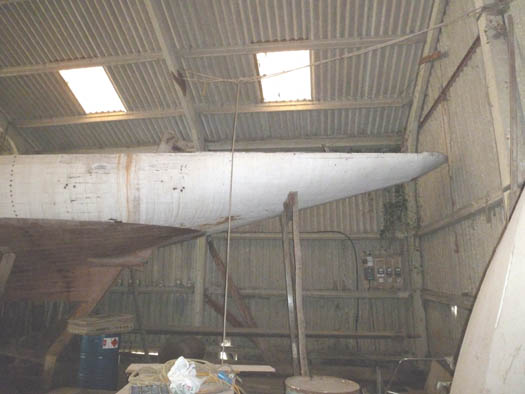
Her counter stern seems more beautiful than ever – this was Charles E Nicholson on top of his form Photo: W M Nixon
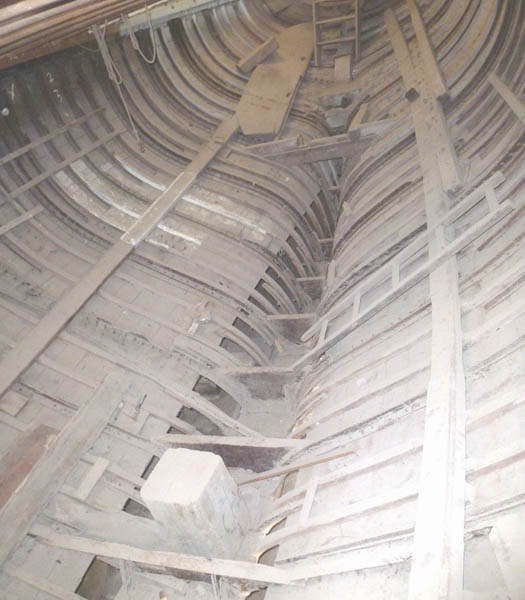
The empty interior, looking aft. The accumulation of dust suggests this restoration has long since ground to a halt. Photo: W M Nixon
Seeing a significant boat merely as unremarkable background is something which can happen to all of us. Back in 1996, we cruised to St Malo in order to see the first yacht built by James Kelly of Portrush. Built in 1897 for Belfast-based cruising pioneer Howard Sinclair, who designed the boat himself, the 40ft Nuada had originally been called Saiph. But Sinclair acquired a taste for having new boats built, so after a year he designed and had James Kelly build a 15-tonner called Yucca (his boat names were just horrible), and Saiph became Nuada in Scottish ownership, and in time a distinguished part of the Clyde Cruising Club fleet for many years.
Somehow or other she found her way to France, and we'd got to hear about her in the ownership of Bernard Julienne of St Malo, so this provided a good excuse to cruise to that wonderful port. We even took along a bottle of Bushmills whiskey to present to Bernard, as it's distilled just six miles from where Nuada had been built, in a little boatyard where James Kelly subsequently built many yachts, including three boats of the Dublin Bay 21 Class, and seven Howth/Dublin Bay 17s.
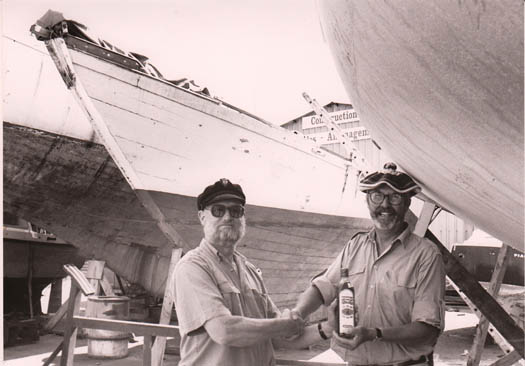
And no, it's not a Convocation of Silly Sailing Hats. In St Malo in 1996 beside the bow of the 40ft Nuada, which was built in Portrush in 1897, Ed Wheeler of the Irish Cruising Club presents a bottle of Bushmills whiskey (distilled just six miles from Nuada's birthplace) to Bernard Julienne, owner of the boat. Photo: W M Nixon
Nuada was in mid-restoration, or rather what people hope is mid-restoration with all the interior stripped out and everything cleared for action. In reality, you're about a tenth of the way there. So naturally much of our interest was in this massive work project, the prospect of which was overpowering. We clowned about a bit with the Bushmills presentation and took our leave, for as it was lunchtime, and this was France, there was nobody around to ask about the boat next door, which was also in a sorry state. She was much bigger than Nuada, and looked really interesting. She was called Pinta.
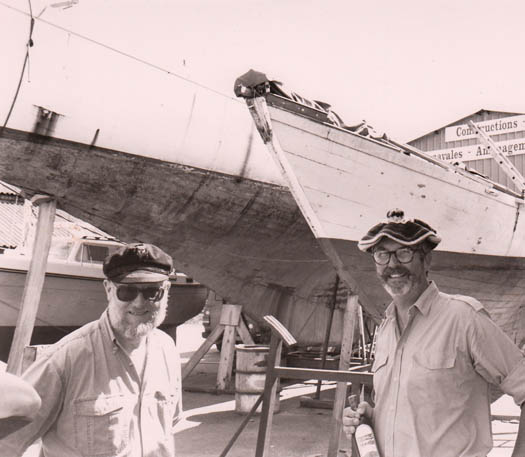 It was only in the post formal clowning around that we got a photo which showed anything of the boat next to Nuada. And it was only later that we discovered she was originally Vanity V from 1936, the last 12 Metre designed and built by Fife of Fairlie. Photo: W M Nixon
It was only in the post formal clowning around that we got a photo which showed anything of the boat next to Nuada. And it was only later that we discovered she was originally Vanity V from 1936, the last 12 Metre designed and built by Fife of Fairlie. Photo: W M Nixon
Some time later we discovered Pinta was originally Vanity V of 1936, the last 12 Metre to be designed and built by Fifes of Fairlie. Like it or not, there's a pecking order in classics. We may have originally gone to St Malo to see the first yacht built by James Kelly. But the fact that we'd been right beside the last and greatest 12 Metre from the Fife stable has become the dominant memory of our time there. Cruel as it was, the restoration or otherwise of Nuada became something very far down the line from a new interest in whether or not Vanity V ever got restored.
Happily, she did. Vanity V has since become an adornment of the Baltic classic yacht scene. Wouldn't you just love to do something similar for Flica?































































